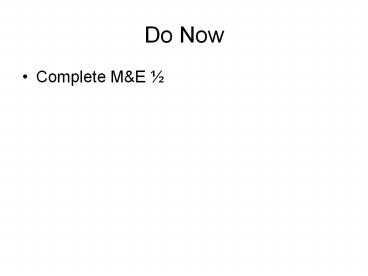Do Now - PowerPoint PPT Presentation
1 / 28
Title:
Do Now
Description:
Factors within and outside an organism that cause it to behave a certain way at a certain time ... Ex: test anxiety, sprinter, basketball free-throw. Sensation Seekers ... – PowerPoint PPT presentation
Number of Views:38
Avg rating:3.0/5.0
Title: Do Now
1
Do Now
- Complete ME ½
2
Motivation
3
Motivation
- A need or desire that energizes and directs
behavior. - Factors within and outside an organism that cause
it to behave a certain way at a certain time
4
Psychology and Motivation
- Motivation connects observable behavior to
internal states. - Motivation accounts for variability in behavior.
- Motivation explains perseverance despite
adversity. - Motives relate biology to behavior.
5
Four Perspectives of Motivation
- Instinct Theory
- Drive-reduction Theory (push and pull)
- Arousal Theory
- Maslows Hierarchy of Needs
6
Types of Motivation
- Drive motivation with a strong biological
component and plays a large role in survival or
reproduction. - Eating, drinking, sexual behaviors
- Motive urges that are mainly learned.
- Video games, money
7
Motives can be biological or learned
- Primary motives biological
- Stimulus curiosity, stimulation
- Secondary learned behavior
8
Types of Motivation
- Intrinsic Motivation comes from within the
individual - Absence of external reward
- Extrinsic Motivation comes from outside the
person. - Behavior aimed at external rewards money,
grades, praise
9
Types of motivation
- Conscious motivation having a desire to engage
in an activity and being aware of the desire. - Unconscious motivation having a desire to
engage in an activity but being consciously
unaware of the desire. - Freud psychoanalytic theory
10
Theories of Motivation
- Group Skits
- Fill in the chart will be checked
11
Instinct Theory
- Emerging in the late 1800s (Darwin), contended
that certain human behaviors are innate and due
to evolutionary programming - Explains some animal
- behaviors
- Explains some human
- behaviors
12
William James Principles of Psychology
Functionalist William James wrote in in his 1890
book that humans have more instincts than any
other mammal
13
Instinct - problems
- Instinct maternal instincts, killer instinct,
the athlete who instinctively catches the ball. - To qualify as an instinct, a behavior must have a
fixed pattern throughout a species and be
unlearned. - Example bird migration, salmon expeditions
- Instinct theories merely describe and label
behaviors rather than actually explaining them.
14
Drive Reduction Theory
- Physiological needs creates an aroused state that
drives the organism to reduce the need. - Need motivated state caused by a physiological
deficit - Drive state of physiological tension induced by
a need
15
Drive-Reduction Theory
- The physiological aim of drive reduction is
homeostasis the maintenance of a steady
internal state. - Examples body regulation system
16
Homeostasis
- A tendency to maintain a balanced or constant
internal state - The regulation of any aspect of body chemistry,
such as blood glucose, around a particular level - Any change in levels, up or down, results in
being motivated to bring the level back to normal.
17
Homeostatic RegulationAn Example
18
Homeostatic Regulation
19
Homeostatic Regulation
20
Homeostatic Regulation
21
Homeostatic Regulation
22
Homeostatic Regulation
23
Homeostatic Regulation
24
Homeostatic Regulation
25
Homeostatic Regulation
26
Any Problems?
- When homeostasis is disrupted, motivation to
restore it drives the behavior. - Why do people sometimes eat when they are not
hungry? - How about the motivation to buy a lottery ticket
or run a marathon?
27
Drive-Reduction Theory
- We are not only pushed by our needs but.
Pulled by our incentives a positive or negative
environmental stimulus that motivates behavior
28
Incentive Theories
- Behavior motivated by the pull of external
goals, such as rewards, money and recognition. - Drew heavily from well-established learning
principles, such as reinforcement, and the work
of learning theorists, such as Pavlov, Watson,
Skinner, and Tolman. - Tolman also stressed the importance of cognitive
factors in learning and motivation, especially
the expectation that a particular behavior will
lead to a particular goal. - Fails to explain behaviors that are not primarily
motivated by any kind of external incentive
29
Drives and Incentives
- When there is a drive and an incentive, we feel
strongly driven. - Example the food-deprived person who smells
baking bread feels a strong hunger drive. - In the presence of that drive, the baking bread
becomes a compelling incentive. - For each motive, ask
- How is it pushed by our drives and pulled by
incentives?
30
Arousal Theories
- Levels of alertness and responsiveness
- People are motivated to maintain an optimum level
of arousalneither too high nor too low - Curiosity motivehelps us understand our
environment
31
Inverted U Function
At very low levels of arousal, youre not
sufficiently energized to perform well. At very
high levels of arousal, your overwhelmed and
panicked.
32
Yerkes-Dodson Law
Ideal level of arousal depends on the complexity
of the task!! If a task if relatively simple, it
is best for arousal to be high. If a task is
more complex, your best performance will occur at
lower levels of arousal.
Ex test anxiety, sprinter,
basketball free-throw
33
Sensation Seekers
- Trait of people who prefer high levels of
stimulation. - Based on how well your body responds to new,
unusual, or intense stimulation. - High Seekers bold, independent, value change
- Low Seekers orderly, giving, enjoy the company
of others - ME HW Assignment Fill out now


























![READ⚡[PDF]✔ Let Us Now Praise Famous Men PowerPoint PPT Presentation](https://s3.amazonaws.com/images.powershow.com/10048407.th0.jpg?_=202406050911)
![⚡Read✔[PDF] Now I Know: The Soviets Invaded Wisconsin?!: ...And 99 More Interesting Facts, PowerPoint PPT Presentation](https://s3.amazonaws.com/images.powershow.com/10071901.th0.jpg?_=20240704011)



